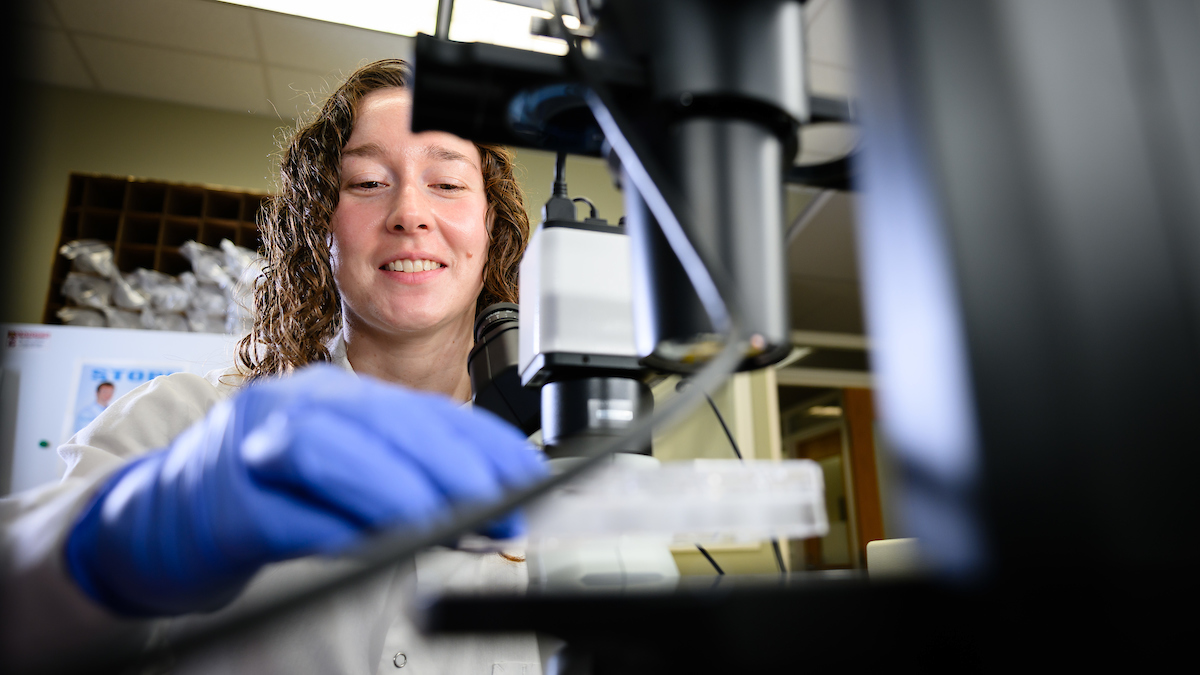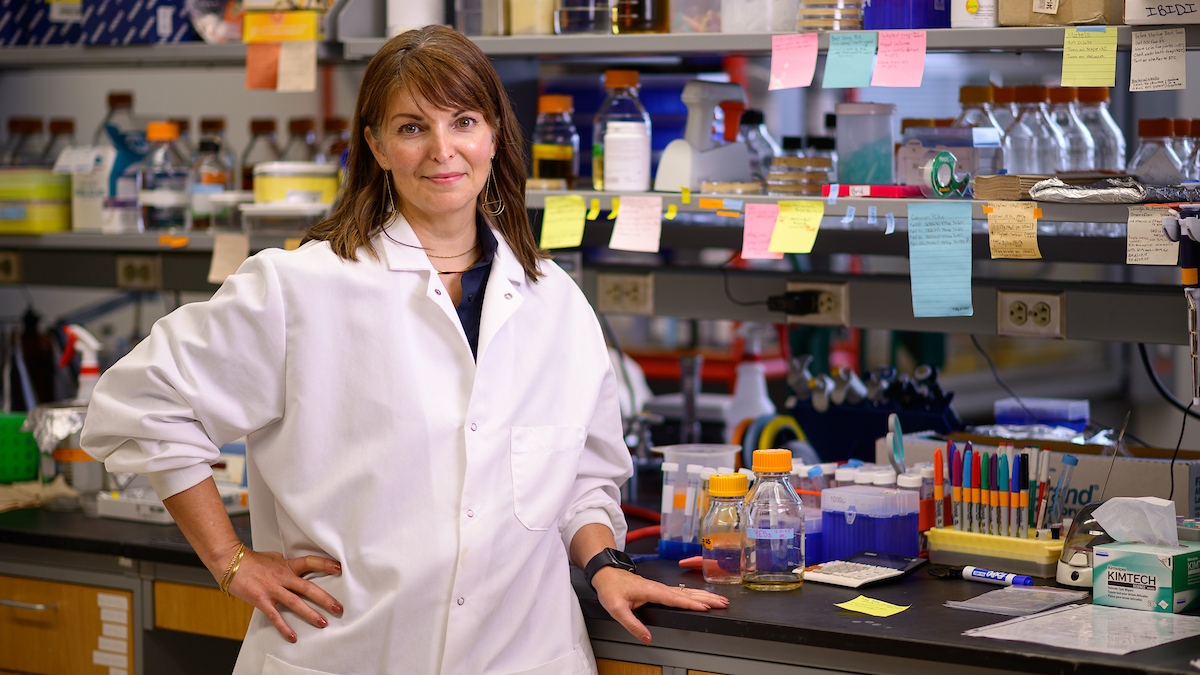November 2019 Research Roundup

A look at some of the latest published research studies coming from the NC State College of Veterinary Medicine this month.
Understanding Canine Blindness
Researchers have identified neurohormone differences between canine sudden acquired retinal degeneration syndrome (SARDS) and canine pituitary-dependent hypercortisolism (PDH), despite the two conditions being clinically similar.
The differences in neurohormone concentrations found in the study could lead to new therapeutic strategies for both conditions. SARDS is a leading cause of acute incurable vision loss in dogs, but its pathogenesis is not well understood and there are no treatments that are proven safe and effective.
The Journal of Veterinary Internal Medicine published the research authored by Freya Mowat, Katharine Lunn, Melanie Foster and Annie Oh..
Galápagos Land Iguana Health
Large land iguanas are among the most recognized animals on the Galápagos archipelago, but little is known about their normal health parameters. A study led by Greg Lewbart fills in some of the blanks.
The research, published in PLoS One, documents stats such as body temperature, heart rate, respiratory rate and body measurements for the species Conolophus pallidus and Conolophus subcristatu. Researchers also compared the data to information on the marine iguana, which shares a common ancestor with the land iguana.
Such information may be useful in health comparisons between captive and wild populations, between wild populations and in detecting changes in health status among the land iguanas, which are impacted by threats such as climate change.
Potential Research Model for Human Allergies
Young pigs may be useful as large animal models in studying human eosinophilic esophagitis, a chronic condition associated with food allergies.
Researchers looked at whether esophagitis, inflammation that damages esophageal tissue, with an eosinophilic component could be seen in young pigs rendered allergic to hen egg white protein. The study found that food allergy in the pigs can be associated with esophagitis based on histological and endoscopic findings, including eosinophilic infiltration.
An eosinophil is type of white blood cell, and eosinophilic esophagitis is when the cells accumulate in the esophagus. The body can produce more eosinophils than typical for a variety of reasons, including responses to allergies, autoimmune diseases and some cancers.
Luke Borst, Tobias Kaeser and Anthony Blikslager are among the authors of the study, published in Clinical & Experimental Allergy.
Treating Dairy Calf Diarrhea
Oral electrolyte products remain the gold standard for treating calves with diarrhea, the primary cause of mortality in newborn dairy cows around the world, according to research published in the Journal of Dairy Science.
The study compared oral, intravenous and subcutaneous fluid therapies for treating dehydration, increasing blood pH levels and providing nutritional support. Oral electrolyte products were most effective in rapidly correcting mild to moderate dehydration and low blood pH. Researchers noted that small infusions of IV fluids are most effective when combined with oral electrolytes.
Subcutaneous fluids were found to be absorbed very slowly and do not appear to be effective for rapid treatment. The study is the first to include data on subcutaneous fluid use in calves.
The study’s authors include Geof Smith, Hongyu Ru and Derek Foster.
Targeted Anti-Cancer Therapies
Enteric glial cells stimulate tumor growth that’s driven by colon cancer stem cells, according to a study led by Laurianne Van Landeghem.
The research, published in Lancet publication EBioMedicine, shows that enteric glial cells, part of the gastrointestinal tract’s nervous system, are active players of colon carcinogenesis, a detail that provides a better understanding of the molecular pathways involved between enteric glial cells and colon cancer stem cells. Such information may lead to new targets in anti-cancer therapies.
Canine Cystotomy Drug Protocols
Using an epidural with bupivacaine reduces opioid consumption during surgery for dogs anesthetized for a cystotomy procedure, according to a study led by Ludovica Chiavaccini.
Researchers compared opioid consumption during surgery and duration of hospitalization in dogs receiving an opioid-based medicine to those receiving epidural-based bupivacaine during the procedure, which requires bladder incision. The results showed that bupivacaine may reduce opioid requirements during cystotomy without affecting bladder function return or length of hospital stay. Veterinary Surgery published the study.
Cystotomies are performed to remove canine bladder stones. Opioids are part of the traditional protocol for such procedures, but there has been an increased push to find alternatives, such as epidural-based general anesthesia.
Tracking an Impactful Zoonotic Disease
A survey of 16 Leptospira species in Brazil sheds new light on the distribution and spread potential of the bacteria that causes Leptospirosis.
The study, published in Transboundary and Emerging Diseases, outlines geographic and ecological features among Leptospira serovars in a subtropical area of Brazil, highlighting environmental conditions facilitating or limiting the spread of Leptospira, as well as reconstructing its distribution. The ecological preferences of Leptospira are not well understood.
The research’s findings could help forecast the potential of transmission to humans and food animals. Leptospirosis is endemic to tropical regions, which often have high densities of domestic animals, wild animals and people. More than 1 million cases of leptospirosis are reported around the world each year. The disease passes from animals to humans through infected animal urine.
Gustavo Machado is the corresponding author of the study, with authors including Manuel Jara and Alba Frias-De-Diego.


